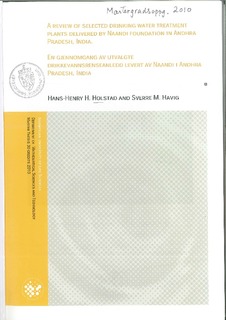A review of selected drinking water treatment plants delivered by Naandi foundation in Andhra Pradesh, India.
Master thesis
Permanent lenke
http://hdl.handle.net/11250/188698Utgivelsesdato
2012-06-01Metadata
Vis full innførselSamlinger
- Master's theses (RealTek) [1722]
Sammendrag
This report is based on experiences from fieldtrips carried out in the period 25.06.10 24.08.10 in Andhra Pradesh, India. Together with Naandi foundation, several villages
were visited to assess small-‐scale drinking water purification plants raised under the
auspices of the observed plants and see if there was any potential improvements or challenges. In this context Naandi expressed a wish that two themes was examined more carefully:
The plants' problems and challenges with focus on water quality, water source and pre
surveys done before the installation and how the concentrate from the drinking water
treatment plants can be handled, with focus on fluoride emission.
A literature review that describes water sources, water quality parameters and
membrane filtration technology used by Naandi was written to provide a better
understanding of Naandis drinking water purification plants.
The results from the observations shows that nearly all the drinking water treatment
plants visited ensured enough clean and safe water to the people in the villages.
According to this, Naandis safe drinking water program works perfectly. However, there were observed challenges connected to the plants that affect the costs, operation and maintenance and the water source. These challenges were borewells with water
shortage, damaged membranes caused by fouling, plants with high maintenance costs as a result of inefficient pretreatment, low recovery rate of the raw water and absent reject water handling.
The quality and quantity of water in the raw water source played a main role in all the
observed challenges and problems. There is suggested, based on the observed
challenges, that Naandi should do a more thorough survey of the water source in terms of water quality and capacity before the plant is buildt and monitore this further during the operation of the plant. This can prevent dry borewells, broken membranes and high maintenance cost and lead to a more efficient operation of the plant.
There is considered several methods to remove fluoride from the reject water but most of them has been considered to be too expensive and therefore not possible to
implement. The best solution is believed to be lime stone filter, because of low costs and
simplicity.
